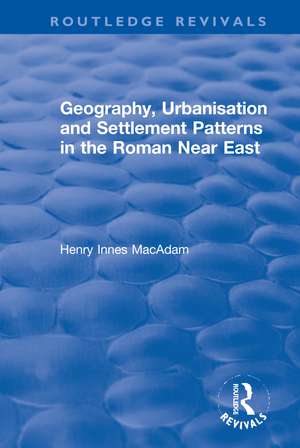Geography, Urbanisation and Settlement Patterns in the Roman Near East: Routledge Revivals
Autor Henry Innes MacAdamen Limba Engleză Paperback – 11 noi 2019
| Toate formatele și edițiile | Preț | Express |
|---|---|---|
| Paperback (1) | 189.85 lei 6-8 săpt. | |
| Taylor & Francis – 11 noi 2019 | 189.85 lei 6-8 săpt. | |
| Hardback (1) | 736.38 lei 6-8 săpt. | |
| Taylor & Francis – 26 sep 2017 | 736.38 lei 6-8 săpt. |
Din seria Routledge Revivals
- 9%
 Preț: 801.71 lei
Preț: 801.71 lei - 8%
 Preț: 432.64 lei
Preț: 432.64 lei -
 Preț: 153.83 lei
Preț: 153.83 lei -
 Preț: 230.80 lei
Preț: 230.80 lei -
 Preț: 309.79 lei
Preț: 309.79 lei -
 Preț: 258.73 lei
Preț: 258.73 lei - 9%
 Preț: 764.35 lei
Preț: 764.35 lei - 9%
 Preț: 903.42 lei
Preț: 903.42 lei -
 Preț: 311.18 lei
Preț: 311.18 lei -
 Preț: 357.45 lei
Preț: 357.45 lei - 9%
 Preț: 606.36 lei
Preț: 606.36 lei -
 Preț: 317.54 lei
Preț: 317.54 lei - 9%
 Preț: 764.30 lei
Preț: 764.30 lei -
 Preț: 257.01 lei
Preț: 257.01 lei -
 Preț: 238.40 lei
Preț: 238.40 lei -
 Preț: 259.48 lei
Preț: 259.48 lei - 9%
 Preț: 903.81 lei
Preț: 903.81 lei -
 Preț: 326.26 lei
Preț: 326.26 lei -
 Preț: 258.67 lei
Preț: 258.67 lei -
 Preț: 294.98 lei
Preț: 294.98 lei -
 Preț: 308.89 lei
Preț: 308.89 lei -
 Preț: 199.86 lei
Preț: 199.86 lei -
 Preț: 347.50 lei
Preț: 347.50 lei -
 Preț: 302.59 lei
Preț: 302.59 lei -
 Preț: 389.40 lei
Preț: 389.40 lei -
 Preț: 257.01 lei
Preț: 257.01 lei -
 Preț: 343.22 lei
Preț: 343.22 lei - 9%
 Preț: 640.91 lei
Preț: 640.91 lei - 9%
 Preț: 619.49 lei
Preț: 619.49 lei -
 Preț: 228.88 lei
Preț: 228.88 lei -
 Preț: 265.16 lei
Preț: 265.16 lei -
 Preț: 245.11 lei
Preț: 245.11 lei -
 Preț: 258.54 lei
Preț: 258.54 lei -
 Preț: 258.73 lei
Preț: 258.73 lei -
 Preț: 368.93 lei
Preț: 368.93 lei -
 Preț: 246.38 lei
Preț: 246.38 lei - 9%
 Preț: 832.08 lei
Preț: 832.08 lei -
 Preț: 258.67 lei
Preț: 258.67 lei -
 Preț: 286.99 lei
Preț: 286.99 lei - 18%
 Preț: 695.86 lei
Preț: 695.86 lei - 9%
 Preț: 934.96 lei
Preț: 934.96 lei - 5%
 Preț: 243.38 lei
Preț: 243.38 lei -
 Preț: 274.69 lei
Preț: 274.69 lei -
 Preț: 200.67 lei
Preț: 200.67 lei - 9%
 Preț: 638.62 lei
Preț: 638.62 lei -
 Preț: 259.69 lei
Preț: 259.69 lei - 9%
 Preț: 1038.47 lei
Preț: 1038.47 lei -
 Preț: 389.46 lei
Preț: 389.46 lei -
 Preț: 302.14 lei
Preț: 302.14 lei -
 Preț: 302.27 lei
Preț: 302.27 lei
Preț: 189.85 lei
Preț vechi: 225.98 lei
-16% Nou
Puncte Express: 285
Preț estimativ în valută:
36.33€ • 38.85$ • 30.29£
36.33€ • 38.85$ • 30.29£
Carte tipărită la comandă
Livrare economică 17 aprilie-01 mai
Preluare comenzi: 021 569.72.76
Specificații
ISBN-13: 9781138740495
ISBN-10: 1138740497
Pagini: 384
Dimensiuni: 170 x 244 mm
Greutate: 0.71 kg
Ediția:1
Editura: Taylor & Francis
Colecția Routledge
Seria Routledge Revivals
Locul publicării:Oxford, United Kingdom
ISBN-10: 1138740497
Pagini: 384
Dimensiuni: 170 x 244 mm
Greutate: 0.71 kg
Ediția:1
Editura: Taylor & Francis
Colecția Routledge
Seria Routledge Revivals
Locul publicării:Oxford, United Kingdom
Cuprins
Contents: Introduction; Cartography and cultural identity: Marinus of Tyre and scientific cartography: the Mediterranean, the Orient and Africa in early maps; Strabo, Pliny, Ptolemy and the Tabula Peutingeriana: cultural geography and early maps of Phoenicia; Ptolemy’s Geography and the Wadi Sirhan; Some Hellenistic toponyms of Phoenicia; Strabo, Pliny the Elder and Ptolemy of Alexandria: three views of ancient Arabia and its peoples; Cities, villages and rural settlements: Philadelphia (Amman, Jordan) in the classical period; Bostra Gloriosa; Cities, villages and veteran settlements: Roman administration of the Syrian Hawran; Settlements and settlement patterns in northern and central Transjordania, c.550-c.750; Some aspects of land tenure and social development in the Roman Near East: Arabia, Phoenicia and Syria; Epigraphy and the Notitia Dignitatum; Epigraphy and village life in southern Syria during the Roman and early Byzantine periods; Fragments of a Latin building inscription from Aqaba, Jordan; A note on the Usays (Jebal Says) inscription; Some notes on the Umayyad occupation of north-east Jordan; Index.
Descriere
This title was first published in 2002: This volume focuses on the Roman provinces of Syria and Arabia, above all the lands now within Lebanon, Syria and Jordan. The first article look at questions of geography, cartography and toponymy, particularly in Strabo, Pliny and Ptolemy. The following sections are concerned with settlement patterns and urban development in the region. In the Roman and early Byzantine periods, the inland areas underwent a gradual transformation, from a semi-sedentary, lightly populated and predominantly rural region, to one of large cities and a network of prosperous, socially sophisticated villages, linked by a network of roads. That change is documented by a wealth of epigraphy from both the urban communities and their outlying settlements (the subject of several articles). By the 4th century, too, Christianity had become the dominant religion and remained such until the arrival of Islam.
